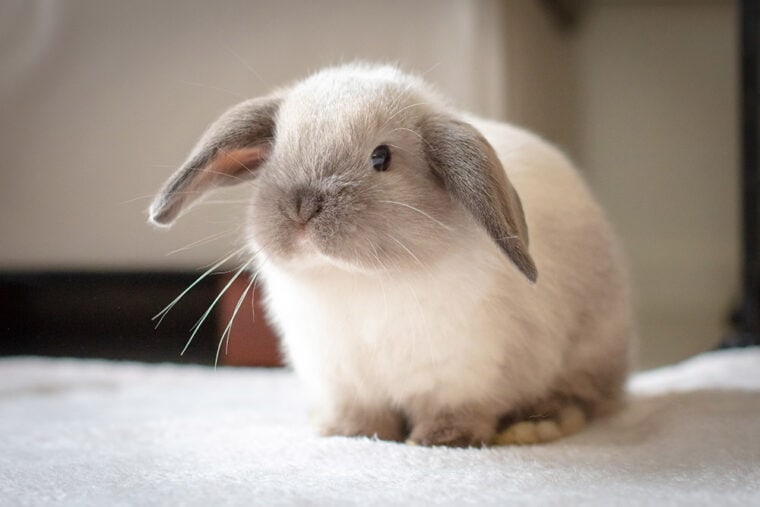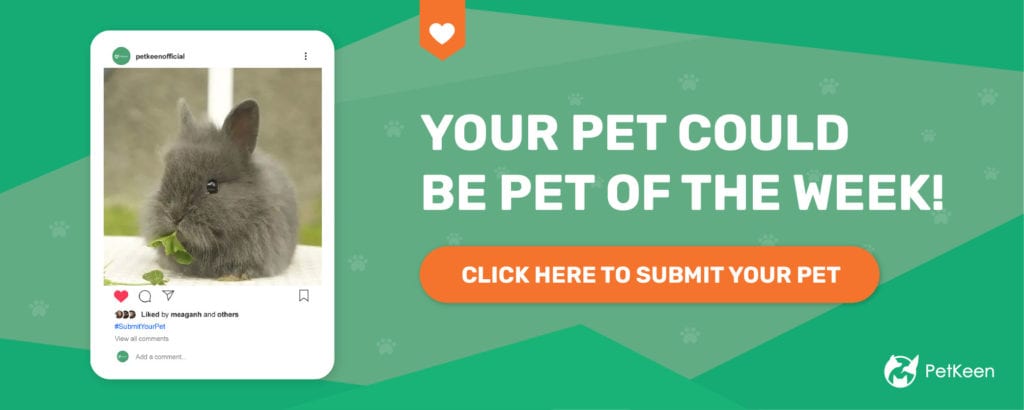
The Mini Lop is a small breed, although not quite a dwarf. Despite this, he is quite stocky and robust. He has lop ears, as the name suggests, and these hang over his face. Mini Lops come in a wide range of colors, according to the American Rabbit Breeders Association.
Like any prey animal, the Mini Lop can be sensitive to noise and sudden movement and, while some owners claim the Mini Lop to be laid-back, it depends on the individual rabbit and not on the general breed. The Mini Lop bunny makes a good family pet, although will require time and regular contact to get the most from your little, long-eared companion.
Quick Facts about the Mini Lop Rabbit
| Species Name: | Oryctolagus cuniculus |
| Care Level: | Medium |
| Temperament: | Even temper, energetic, playful |
| Lifespan: | 7 – 14 years |
| Size: | Small |
| Diet: | Hay, fruit, vegetables, herbs |
| Minimum Cage Size: | 12 square feet |
| Cage Set-Up: | Cage, bottle, bowl, bedding, toys |
| Compatibility: | Prefer to live in pairs |

Mini Lop Rabbit Overview
The Mini Lop breed of rabbits was established in Germany in the 1950s, when several breeds, including the Chinchilla, English Lop, French Lop, and Dwarf Lop, were combined to create a breed that was initially called the Klein Widder.
It was recognized in Germany in 1973 and by the American Rabbit Breeders Association in 1980 after it changed its name to the Mini Lop. Since then, the Mini Lop has become one of the most popular domestic breeds in the US. It is popular because it is relatively small, without being too fragile. It is hardy and healthy and has a long lifespan.
Lop breeds are renowned for being laid-back, although the individual rabbit ultimately determines how friendly, energetic, and bright the rabbit is. However, the Mini Lop certainly can become a loving and well-integrated member of the family. He is no more difficult to care for than other breeds and has similar health concerns. The breed is not only popular with its owners, but an increasing number of videos and even social media accounts belonging to these energetic, friendly, and attractive little animals can be found online.
How Much Do Mini Lops Cost?
As with most pets, the price you pay is determined by several factors. Chief among these factors is whether you want a Mini Lop as a pet or for exhibitions and shows. Pet rabbits are available between $30 and $100, while show quality rabbits can cost up to $500. Do try to meet the rabbit’s mother, if possible, because this can give some indication of the likely size and even the temperament of your rabbit.
As well as the cost of the rabbit itself, expect to pay up to $150 for the cage and other costs. You will also pay around $20 per month ongoing costs.

Typical Behavior & Temperament
As a Lop breed, the Mini Lop has a reputation for being very calm. However, this isn’t always the case. Others have described the Mini Lop as being energetic.
Spend as much time as possible with your rabbit when it is young. This will ensure they are comfortable around you.
Appearance & Varieties
There are several accepted color variations of Mini Lop rabbits, according to the American Rabbit Breeders Association. The available color groups are:
The Mini Lop will weigh no more than 6.5 pounds. Does are smaller than bucks and all are considered to be small, fuzzy, balls of energy. Despite their size, the Mini Lop will be muscular and have a short and stocky neck. The rounded ears fall over the rabbit’s face and the rollback fur has a soft underlayer. Mini Lops are larger than Holland Lops, which is how the two breeds can usually be discerned.
How to Take Care of Mini Lop Rabbits
Habitat
The Mini Lop Rabbit is a domestic breed and it does not exist in the wild. As such, there are no natural conditions for this precise breed. However, there are certain conditions you should meet to ensure that your Mini Lop has everything it requires to be fit and healthy.
Cage
Rabbit guides tell you to choose a cage that is at least four times the length of the rabbit, but this doesn’t allow much room to run around. The ideal cage for a Mini Lop is 12 square feet, but they will benefit from having more space. If you have a bonded pair of rabbits, you will need a larger cage.
As well as cages, you can buy exercise pens to extend the room that they have, or you can provide a rabbit-proof room for your furry friend. If you do provide a room, rabbit-proof it first. Your Lop will eat just about anything that looks tasty, which can include any wooden or soft item. It may also include wires, so you have to protect them from the potential dangers of electrical wires.

Setup
Indoor rabbits need soft bedding. This will need changing every week and spot cleaning every day.
If your rabbit will be living outside, they should have a home that is off the ground but has a ramp down to the grass where they can stretch their legs and exercise while chewing on their food.
Other Care Considerations
Whatever type of enclosure you have, you will need to spend plenty of time with your Mini Lop. This time enables you to form a close bond with the rabbit, and they with you. It will enable them to trust you and should prevent them from biting or trying to escape. The Mini Lop will form a close bond with all their human family, as long as you spend enough time together.

Do Mini Lops Get Along with Other Pets?
Mini Lops prefer to live as part of a bonded pair. You should give two rabbits time to get to know one another before putting them in the same enclosure, but once they have gotten acquainted, they will provide company for one another.
Rabbits are prey animals, and even Mini Lops, which have never lived in the wild, have a natural response. If they perceive danger, they will try to dart away. Potential danger can include loud noises and bright lights, as well as other pets including cats and dogs, so they may not mix well with other animals.
What to Feed Your Mini Lop Rabbits
Mini Lops should be fed a diet that is 70% hay. This should be good quality, for example, Orchard or Timothy hay, but you can feed other grasses as an occasional snack. The remainder of their diet should be made up of fruits, vegetables, and pellets. Pellets are especially important because they help provide the vitamins and minerals that they do not get from their everyday food.

Keeping Your Mini Lop Healthy
Not susceptible to any particular disease, Mini Lops are prone to most of the same illnesses as other rabbit breeds. As well as ensuring that they have adequate housing and a good diet, you will also need to provide regular grooming. Like cats, rabbits clean themselves and remove dead fur by licking, but they are unable to vomit, which means that any fur they ingest can cause a blockage in the stomach. Brush them regularly, and feed plenty of roughage to ensure that they can better pass any ingested fur.
Watch out for signs of overgrown teeth. Their teeth grow throughout their lives and are usually worn down by chewing on hay, but can pierce their cheeks if left unchecked to grow too long.
Breeding
It is recommended that you leave the breeding of Mini Lop rabbits to professional breeders. Successful breeding can lead to very large litters, and this requires a lot of space to keep them comfortable and safe. Rabbits also become sexually active at a very young age, which means that, unless you have homes for them before they are born, the problem is self-replicating and can get out of hand very quickly indeed.
Are Mini Lop Rabbits Suitable For You?
If you are looking for a friendly and small to medium-sized rabbit that is likely to be energetic and friendly, and may also be laid-back and very easy to get along with, then the Mini Lop is a good choice. They are referred to as fuzzy, friendly balls, and this perfectly sums up the temperament of most of these rabbits.
Mini Lop rabbits are no more difficult to care for than any rabbit, and they are not especially susceptible to any specific diseases or illnesses. Although, you do need to ensure that they have plenty of room, a decent diet, and that you spend lots of time with them to socialize and acclimate them to human contact.
Featured Image Credit: FiledIMAGE, Shutterstock










